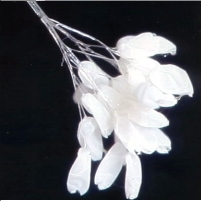Chinese Government Forbids Reporting on Blooming of Rare Flower
Tuesday, March 23, 2010
 Subversive flower (photo: ntdtv)
Subversive flower (photo: ntdtv)
In preparation for the annual meetings of the National People’s Congress and the Chinese People’s Political Consultative Conference, the Chinese government has issued a harsh set of restrictions to China’s media. According to The New York Times, these include:
1) a directive forbidding the reporting of negative news on the front pages of newspapers or the headline news sections of websites;
2) a demand that all reporting about laws relating to elections rely only on stories produced by the Xinhua News Agency (the government’s official news outlet) and the People’s Daily (published by the Communist Party);
3) a prohibition against featuring “news articles that will have a major impact.”
Other restrictions are what one might expect of a totalitarian regime, such as restrictions on reporting about financial and environmental scandals and corrupt officials. But there is one forbidden story that stands out as a bit more unusual.
Editors should not run stories on the rare youtan poluo flower (a.k.a. udumbara flower), which allegedly blooms every 3,000 years. Apparently, a Buddhist nun found a cluster of the small white flowers underneath a washing machine in the Lushan Mountains of Jiangxi province. In most parts of the world, this discovery would fall under the category of “Unusual News,” but to the paranoid and insecure Chinese Communist leadership, the flower is a threat because it could increase interest in Buddhism at a time when the Chinese government is trying to eliminate the influence of religion.
-David Wallechinsky
What Chinese Censors Don’t Want You to Know (New York Times)
In Search of the Flower that Blooms Every 3,000 Years (by Simone Preuss, Environmental Graffiti)
- Top Stories
- Unusual News
- Where is the Money Going?
- Controversies
- U.S. and the World
- Appointments and Resignations
- Latest News
- Trump to Stop Deportations If…
- Trump Denounces World Series
- What If China Invaded the United States?
- Donald Trump Has a Mental Health Problem and It Has a Name
- Trump Goes on Renaming Frenzy






Comments